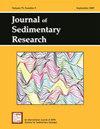大型峡谷冲刷事件后海仓峡谷近海底沉积物的动态迁移
IF 2
4区 地球科学
Q1 GEOLOGY
引用次数: 0
摘要
海底峡谷是重要的深海环境,也是转移和积累沉积物、有机物和污染物的通道。最近在观测、取样和分析现代峡谷沉积物迁移系统方面取得的进展说明了近海底动力学,并强调了海底峡谷在深海迁移和储存有机碳、养分和污染物方面的潜在作用,对深海生态系统和全球碳预算具有影响。新西兰奥特亚罗瓦州 Te Waipounamu 南岛东北部近海的 Kaikōura 峡谷是一个底栖生物量热点地区,2016 年经历了一次由地震引发的峡谷冲刷事件。在 2020 年 10 月返回峡谷时,沿峡谷轴线在水深约 900-1500 米处部署了底栖着陆器,沉积物捕获器位于海底以上 2 米处,为期三周。这些仪器平台提供了峡谷冲积喷口之间近海底沉积物和有机碳迁移的详细情况,表明峡谷环境中存在动态物理过程和短期沉积物通量与迁移。峡谷沉积物和有机碳通量的变化以及随时间的变化包括小规模的沉积物迁移事件,其中一些被解释为浊流,其发生的时间尺度比地震复发的时间尺度要短得多。我们将海古拉峡谷的研究结果与其他长岸馈源、陆架入海的全球海底峡谷和深海地点进行了比较,揭示了近海底沉积物通量的差异和可能的多重控制因素。这个 Kaikōura Canyon 高分辨率底栖着陆器时间序列数据集突出了海底峡谷的复杂性及其在有机碳通向深海中的作用,即使是在当今的高海平面条件下也是如此。不断发展的认识突出表明,需要更多的观测数据和样本,以进一步量化海底峡谷沉积物和有机碳迁移,并促进对深海峡谷分布系统的全球评估。本文章由计算机程序翻译,如有差异,请以英文原文为准。
Dynamic near-seafloor sediment transport in Kaikōura Canyon following a large canyon-flushing event
Submarine canyons are important deep-sea environments and conduits for transferring and accumulating sediment and organic matter and pollutants. Recent advances in observing, sampling, and analysing modern canyon sediment transport systems illustrate near-seafloor dynamics and highlight the potential roles of submarine canyons in transporting and storing organic carbon, nutrients, and contaminants in the deep sea, with implications for deep-sea ecosystems and global carbon budgets. Kaikōura Canyon, offshore northeastern Te Waipounamu South Island, Aotearoa New Zealand, is a benthic biomass hotspot that experienced an earthquake-triggered, canyon-flushing event in 2016. On return to the canyon in October 2020, benthic landers, with sediment traps at 2 m above the seafloor, were deployed along the canyon axis in approx. 900–1500 m water depths for a period of three weeks. These instrumented platforms provide a detailed view of near-seafloor sediment and organic carbon transport between canyon-flushing e vents, showing that the canyon environment hosts dynamic physical processes and short-term sediment fluxes and transport. Variations in sediment and organic carbon flux down-canyon and over time include small-scale sediment transport events, some of which are interpreted as turbidity currents, occurring on much shorter timescales than earthquake recurrence. We compare Kaikōura Canyon results with other longshore-fed, shelf-incised global submarine canyons and deep-ocean sites, revealing differences and likely multiple controlling factors for near-seafloor sediment flux. This Kaikōura Canyon high-resolution, benthic lander timeseries dataset highlights the complexity of submarine canyons and their role in organic carbon flux to the deep ocean, even under high present-day sea-level conditions. Evolving insights underscore the need for more observational data and samples to further quantify submarine canyon sediment and organic carbon transport and contribute to global evaluations of deep-sea canyon distribu tary systems.
求助全文
通过发布文献求助,成功后即可免费获取论文全文。
去求助
来源期刊
CiteScore
3.80
自引率
5.00%
发文量
50
审稿时长
3 months
期刊介绍:
The journal is broad and international in scope and welcomes contributions that further the fundamental understanding of sedimentary processes, the origin of sedimentary deposits, the workings of sedimentary systems, and the records of earth history contained within sedimentary rocks.

 求助内容:
求助内容: 应助结果提醒方式:
应助结果提醒方式:


